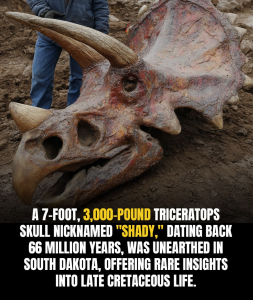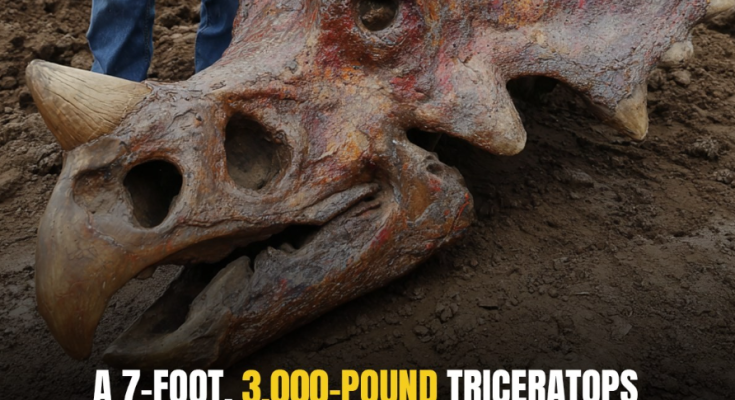
Meet “Shady,” the Giant Skull of the Badlands
The Badlands of South Dakota have long been a place of awe and mystery. Stretching across eroded buttes, jagged pinnacles, and layered rock formations, this rugged landscape tells the story of millions of years of history. Fossil hunters, geologists, and travelers are drawn to its otherworldly beauty, each hoping to uncover a fragment of its ancient past. But among the countless discoveries hidden in its rocky maze, one recent find has captured imaginations more than most: the massive fossilized skull nicknamed “Shady.”
This colossal skull—towering over scientists who stand beside it—has been hailed as one of the most remarkable paleontological finds in the region in decades. Its size, condition, and mysterious origins have sparked debates, theories, and excitement that extend far beyond South Dakota.
The Discovery
“Shady” was unearthed by a team of paleontologists working in a remote corner of the Badlands in early summer. At first, the team believed they had stumbled upon an unusually large rock formation protruding from the earth. However, after closer inspection, they realized the shape bore distinct anatomical features: eye sockets, nasal cavities, and jaw structures. What they initially dismissed as stone turned out to be an enormous fossilized skull, embedded in sediment that had protected it for millions of years.
The excavation process was painstaking. It required weeks of careful digging, brushing, and stabilization to ensure the fossil wasn’t damaged. Bit by bit, more of the skull emerged from the rock until its full magnitude was revealed. Standing over eight feet in length and nearly six feet across, “Shady” dwarfed many known fossilized skulls discovered in the region.
Naming “Shady”
Why the name “Shady”? According to the excavation team, the nickname came naturally during the dig. The skull’s immense brow ridge cast a wide shadow across the dig site each afternoon as the sun dipped low. One crew member joked that the fossil “throws more shade than a mountain,” and the name stuck. Now, “Shady” has become a term of endearment not only for the skull itself but also for the broader story surrounding its discovery.
Scientific Significance
Experts are still studying “Shady” to determine exactly what species it belonged to. Early theories suggest it may have been a massive prehistoric mammal from the late Eocene epoch, a time when the Badlands teemed with bizarre creatures. Others speculate it could represent an entirely new species, one not previously documented in fossil records.
The size alone makes “Shady” extraordinary. Few fossils found in the Badlands have revealed skulls of such magnitude. For paleontologists, this offers a rare chance to expand our understanding of the megafauna that once roamed North America. Was “Shady” a predator at the top of the food chain? Or a gentle giant adapted to grazing the plains? The answers could rewrite sections of the fossil history of the Badlands.
The Badlands as a Fossil Hotspot
To appreciate the significance of “Shady,” one must understand the Badlands themselves. This region has long been a treasure trove for paleontology. Rich deposits of sedimentary rock preserve fossils dating back tens of millions of years, including remains of ancient rhinoceroses, saber-toothed cats, alligators, and three-toed horses.
In fact, the Badlands were central to the birth of paleontology in America. Early fossil expeditions in the 19th century brought global attention to South Dakota, turning it into one of the most studied fossil beds in the world. Even now, new discoveries regularly emerge, each one adding another piece to the puzzle of Earth’s prehistoric past.
Against this backdrop, “Shady” represents both continuity and surprise: continuity in the sense that the Badlands continue to yield incredible finds, and surprise because even in a region so well studied, nature can still present astonishing secrets.
Public Fascination
News of “Shady” spread quickly after the discovery was confirmed. Photos of scientists standing next to the skull went viral online, sparking excitement far beyond the paleontological community. Children marveled at the sheer size, amateur fossil hunters speculated about its origins, and artists began sketching reconstructions of what the creature might have looked like in life.
The nickname itself also helped. “Shady” carries a playful quality that invites curiosity. Unlike the long Latin scientific names often associated with fossils, “Shady” feels approachable, memorable, and easy to rally around. Museums and merchandise producers have already expressed interest in using the name as a hook for exhibitions and educational materials.
Educational Impact
For educators, “Shady” provides a golden opportunity to spark interest in paleontology and geology. Teachers in South Dakota and beyond have begun incorporating the discovery into classroom discussions, using it to illustrate how fossils form, how excavations are conducted, and why such discoveries matter.
Children are particularly captivated by the mystery: What did “Shady” eat? How did it die? Was it part of a herd, or a solitary wanderer? These questions transform science into an adventure story, fueling curiosity and critical thinking. Museums are already planning interactive exhibits that will allow visitors to engage with replicas of the skull and learn about the processes that preserved it.
The Debate Among Experts
While excitement runs high, experts remain cautious. Paleontology is a field built on careful analysis, and definitive answers about “Shady” could take years to emerge. Already, debates have begun. Some argue that the skull’s features resemble known species, meaning it may not represent an entirely new creature. Others insist the proportions are too unusual to fit existing classifications, suggesting “Shady” could reveal a previously unknown branch of prehistoric life.
Whatever the final verdict, the discovery highlights the importance of patience in science. “Shady” is not just a fossil but a riddle—a reminder that the Earth still holds stories we are only beginning to understand.
Preserving the Find
Currently, “Shady” is being carefully prepared for transport to a laboratory where it will undergo cleaning, analysis, and preservation. Scientists will use advanced imaging techniques, including 3D scanning, to capture every detail. These scans will allow digital reconstructions and potentially even life-sized models to be shared with the public while the original fossil remains protected.
Preservation is critical, as fossils of this size are fragile despite their stone-like appearance. Each crack and crevice must be stabilized to ensure the skull survives not only for research but also for future generations to marvel at.
Looking to the Future
So what lies ahead for “Shady”? Once fully studied, the skull is expected to be displayed in a museum, likely within South Dakota. Such an exhibition would attract visitors from around the world, boosting tourism while also highlighting the state’s scientific and natural heritage. Educational programs, documentaries, and research papers will follow, ensuring that “Shady” leaves a lasting mark not only on science but also on culture.
The discovery also serves as a reminder of how much remains hidden beneath the earth’s surface. If something as massive as “Shady” could remain buried for millions of years before emerging, what other secrets might the Badlands still hold?
Closing Thoughts
“Shady,” the giant skull of the Badlands, is more than just a fossil. It is a symbol of discovery, mystery, and the enduring allure of the natural world. For scientists, it is a once-in-a-generation opportunity to learn more about prehistoric life. For the public, it is a story of wonder and imagination, proof that our planet continues to surprise us.
As researchers work to uncover its secrets, one truth already shines clear: “Shady” has captured the world’s attention, and in doing so, has secured a place in the rich and fascinating history of the Badlands.

